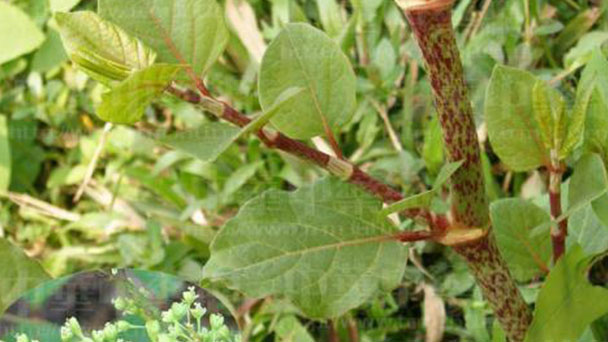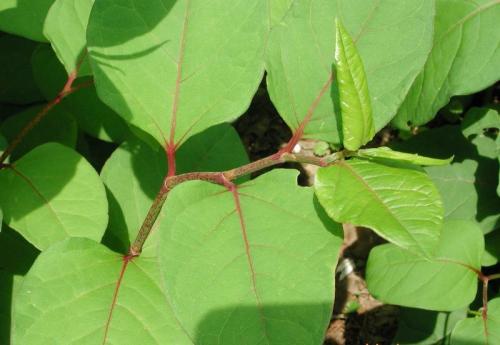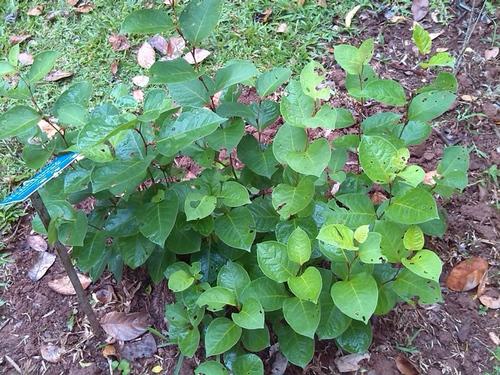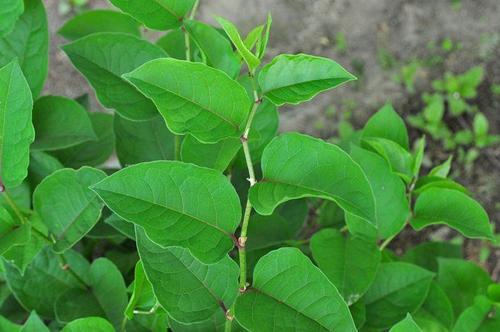Japanese knotweed (Reynoutria japonica) profile
Written by Maggie
Mar 11 2021

Japanese knotweed (Polygonum cuspidatum) is a perennial herb of the genus Polygonaceae. Japanese knotweed is a plant of the genus Japanese knotweed. Rhizome is stout, transverse. The stem is upright, not only for watching, but also for food. The tender stem is made into vegetables, and the root is made into a cold drink, which is cooled in cold water (it is better to chill in the refrigerator). The "cold drink" is a refreshing tea for the summer.Its liquid can dye rice flour, an unique flavor. Edible with its sour taste, it is also known as "sour soup pole." Japanese knotweed contains polygonoside, organic acid, glucoside, polysaccharide, etc.It has functions of clearing away heat and detoxification, cooling and relieving heat, nourishing stomach and clearing food. Japanese knotweed is a plant of Polygonaceae.South Shaanxi, South Gansu, East China, Central China, South China, Sichuan, Yunnan and Guizhou;North Korea, Japan.
Japanese knotweed picture

Morphological characteristics of Japanese knotweed
Stems
Japanese knotweed is a perennial herb. Rhizome is stout, transverse. Stems are erect, 1-2 m tall, stout, hollow, with conspicuous longitudinals, with small protuberances, glabrous, scattered with red or purplish spots.
Leaf
Leaves of Japanese knotweed are broadly ovate or ovate-elliptic, 5 -- 12 cm long and 4 -- 9 cm wide, subleathery, apically acuminate, base broadly cuneate, truncate, or suborbicular, margin entire, sparsely protuberant, glabrous on both sides, with protuberances along veins; Petiole of Japanese knotweed is 1 -- 2 cm long, with small protuberances; Ostile sheaths are membranous, oblique, 3-5 mm long, brown, longitudinally veined, glabrous, apically truncated, glabrous, often ruptured, caducous.
Flowers
Flowers of Japanese knotweed unisexual, dioecious, paniculate, 3-8 cm long, axillary; Bracts are funnelform, 1.5-2 mm long, apically acuminate, glabrous, with 2-4 flowers per bract; Pedicels are 2 -- 4 mm long, proximally articulate; Perianth is 5-lobed, pale green, male perianth segments with green midvein, wingless, stamens 8, longer than perianth; Female perianth outer 3 dorsal winged, fruited when enlarged, wings extended decurrently, style 3, stigma fimbriate. Achene of Japanese knotweed is ovate, 3-rowed, 4-5 mm long, dark brown, lustrous, enclosed in persistent perianth.
The ecological habits of Japanese knotweed
Japanese knotweed prefers warm, humid climates and is not very strict with soil. It cannot grow normally in low-lying areas prone to flooding.
The root system of Japanese knotweed is well developed, with strong drought and cold tolerance. After turning green, the stem grows rapidly, and when it reaches a certain height, the leaves begin to branch and then spread out.
How to grow and care for Japanese knotweed
Light
Japanese knotweed loves the sun, and the stronger the sun, the more it grows.Always give enough light, away from the shade. It is important to avoid exposure to the sun in summer, as the plants will suffer from sunburn and damage to their leaves.
Soil
Although it is not high on the soil requirements, but also want to choose a thick soil layer, fertile loose, breathable drainage field, usually in the front and back of the house, the field, ditch, stream side can be planted, but remember to turn the land.
Temperature
Japanese knotweed is a plant that is remarkably tolerant of drought and cold. It is a plant that does not need much care, as long as it is protected from the cold and sun, and watered frequently.
Nutrient
1500 to 2000 kilograms of fully decomposed barnyard manure should be applied to each acre of tilling soil as base fertilizer, and appropriate phosphorus and potassium compound fertilizer should be sprinkled when planting, about 20 to 25 kilograms per acre.
Pruning
Japanese knotweed grows quickly, and so do all kinds of weeds, so be sure to weed them. Otherwise, the nutrients in the soil will be absorbed by all kinds of weeds, and it is necessary to loosen the soil appropriately to give it a good growth environment.

Propagation of Japanese knotweed
Seed propagation
Direct seeding or seedling transplanting can be used. For 3-4 months, the hole spacing was 33cm, each acupoint was sown with 8-9 seeds and covered with soil of 3cm. Drill sowing, according to the row spacing of 33 ~ 45cm open shallow trench sowing, after sowing overlay soil watering. Seedling, spread or drill in the seedbed, covered with fine soil 1.5cm, often keeps the soil moist. After the seedlings were unearthed, thinning, weeding, and transplanting when the seedlings were 7 ~ 10cm high.
Division propagation
Before turning green, take the mother plant of Japanese knotweed, separate the root head, and take 1 to 2 buds on each root, and then plant.
The distribution region of the Japanese knotweed
Japanese knotweed is produced in southern Shaanxi, southern Gansu, eastern, central, southern China, Sichuan, Yunnan, and Guizhou;North Korea, Japan.
Japanese knotweed is distributed in Shandong, Henan, Shaanxi, Hubei, Hunan, Jiangxi, Fujian, Taiwan, Yunnan, Sichuan, Guizhou, Guangdong, and Anhui.
Disease control of Japanese knotweed
Japanese knotweed is highly resistant to pests and diseases. Serious pests and diseases have never been found in Japanese knotweed.
Japanese knotweed uses
The root of Japanese knotweed is a yellow dye that can also be used medically to promote blood circulation, remove blood stasis, circulate menstruation, and relieve cough.
How to control Japanese knotweed
As with most invasive plants, Japanese knotweed can shortly inhabit disturbed ecosystems. One of the nice approaches to stop its colonization is to make sure that disturbed habitats are rehabilitated with native vegetation earlier than knotweed can invade.
Mechanical control
Single younger flowers can be pulled by way of hand relying on soil prerequisites and root development. If all of the root gadgets aren't removed, re-sprouting can occur. For small preliminary populations past single plants, or in environmentally touchy areas the place herbicides can't be used, grubbing with a pulaski or comparable device to do away with all of the roots after slicing lower back the standing vegetation can be an high-quality managed measure. All components of the eliminated vegetation have to be bagged and disposed of in a tightly closed location. It is first-rate if knotweed now not be mown or reduced with weed trimmers as the portions of the plant can effortlessly get moved round and re-sprout, spreading, alternatively than controlling the plant.
Chemical control
Chemical controls for Japanese knotweed encompass software of glyphosate and triclopyr herbicides to freshly reduce stems or to foliage. Before the usage of chemical compounds to manipulate any invasive plant, take a look at your neighborhood environmental or herbal sources administration organization or Cooperative Extension workplace to discover what chemical substances are felony for use on knotweed in your area.

Latest Updated
- Benefits of Bugleweed - 7 Science-backed Health Benefits
- Bugleweed Dangers & Side Effects - Is It Poisonous?
- How to Plant Evergreen Trees - What You Should Know
- When to Plant Evergreens - Grow Guide for Evergreen Trees
- 12 Wonderful Evergreen Shrubs for Your Garden
- 12 Popular Evergreen Plants with Pictures for Beginners
- When And How To Prune A Lilac Bush Like a Pro
- How to Grow & Care for Lilac Vine (Hardenbergia Violacea)
- Japanese Lilac Tree (Syringa Reticulata) Care & Propagation Guide
- Shumard Oak Pros and Cons - What to Know
Popular Articles
- Winter maintenance of Antirrhinum Majus
- How to Grow Terminalia Mantaly Tree
- How to Grow and Care for Crossostephium Chinense
- How to grow Antirrhinum Majus in spring
- Peristeria Elata (Dove Orchid) Profile: Info & Care Guide
- Underwatered Snake Plant (Sansevieria Trifasciata) - Signs And How To Fix
- How to Care for Brazilian Jasmine Plant (Mandevilla Sanderi)
- How to Grow & Care for Graptopetalum Purple Delight in Summer
- Rosa Chinensis (China Rose): Plant Growing & Care Tips
- How to Care for Baby Sun Rose (Aptenia Cordifolia)